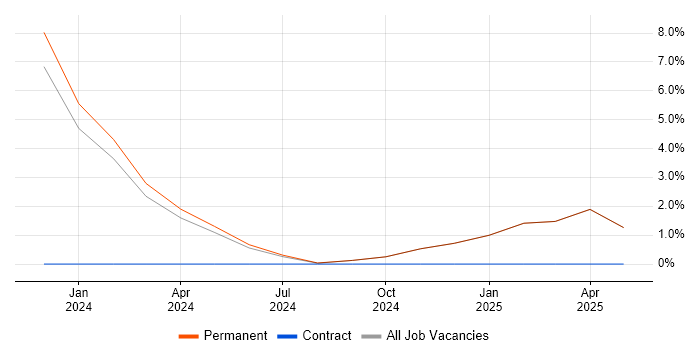Go (Golang)
Warwickshire > Stratford-upon-Avon
The table below provides summary statistics for permanent job vacancies advertised in Stratford-upon-Avon requiring Go skills. It includes a benchmarking guide to the annual salaries offered in vacancies that cited Go over the 6 months leading up to 1 June 2025, comparing them to the same period in the previous two years.
| 6 months to 1 Jun 2025 |
Same period 2024 | Same period 2023 | |
|---|---|---|---|
| Rank | 14 | 21 | - |
| Rank change year-on-year | +7 | - | - |
| Permanent jobs citing Go | 1 | 3 | 0 |
| As % of all permanent jobs advertised in Stratford-upon-Avon | 2.27% | 2.11% | - |
| As % of the Programming Languages category | 8.33% | 13.04% | - |
| Number of salaries quoted | 0 | 3 | 0 |
| Median annual salary (50th Percentile) | - | £77,000 | - |
| Warwickshire median annual salary | £57,500 | £77,000 | £84,250 |
| % change year-on-year | -25.32% | -8.61% | - |
All Programming Languages
Stratford-upon-Avon
Go falls under the Programming Languages category. For comparison with the information above, the following table provides summary statistics for all permanent job vacancies requiring coding skills in Stratford-upon-Avon.
| Permanent vacancies with a requirement for coding skills | 12 | 23 | 71 |
| As % of all permanent jobs advertised in Stratford-upon-Avon | 27.27% | 16.20% | 29.71% |
| Number of salaries quoted | 8 | 21 | 64 |
| 10th Percentile | £49,125 | £45,000 | - |
| 25th Percentile | £52,500 | £50,000 | £37,500 |
| Median annual salary (50th Percentile) | £55,000 | £57,500 | £54,250 |
| Median % change year-on-year | -4.35% | +5.99% | +20.56% |
| 75th Percentile | £57,500 | £72,500 | £60,000 |
| 90th Percentile | - | £79,500 | £67,500 |
| Warwickshire median annual salary | £52,500 | £51,000 | £52,500 |
| % change year-on-year | +2.94% | -2.86% | +16.67% |
Go
Job Vacancy Trend in Stratford-upon-Avon
Job postings citing Go as a proportion of all IT jobs advertised in Stratford-upon-Avon.

Go
Co-occurring Skills and Capabilities in Stratford-upon-Avon by Category
The follow tables expand on the table above by listing co-occurrences grouped by category. The same employment type, locality and period is covered with up to 20 co-occurrences shown in each of the following categories:
